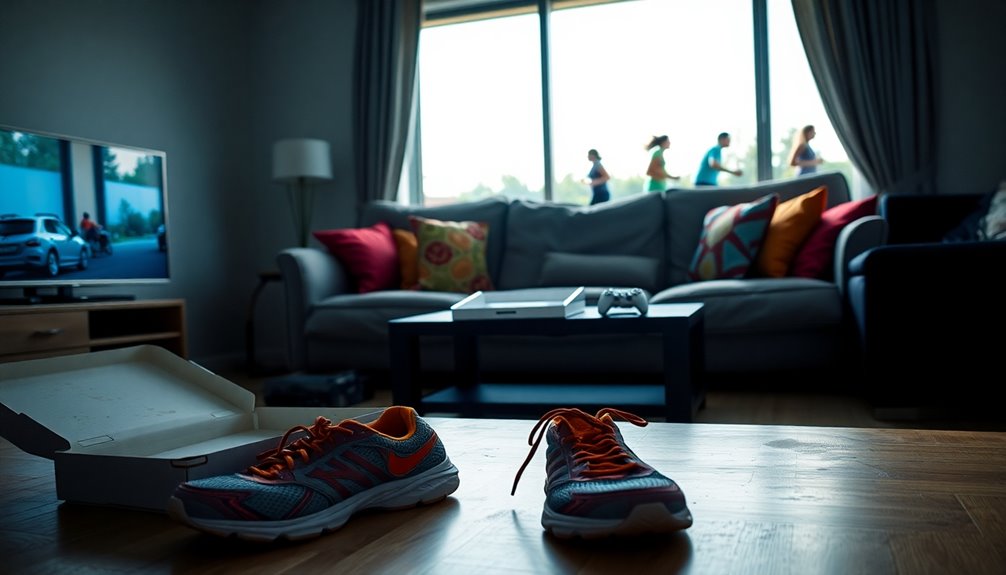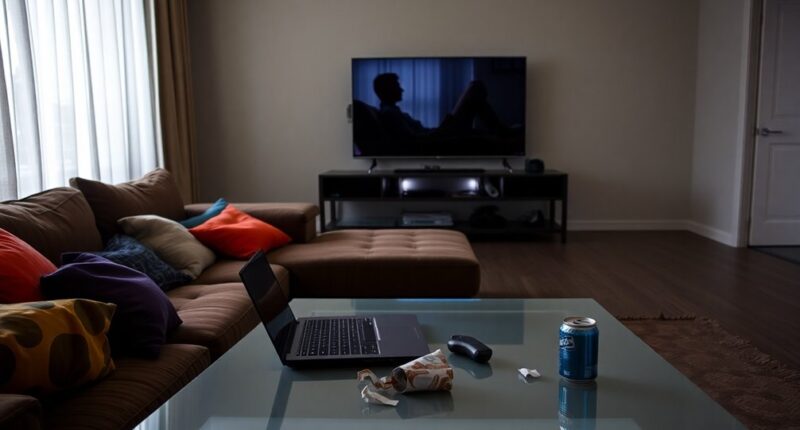A sedentary lifestyle means you spend most of your day sitting or lying down, often exceeding six hours daily. It's common with office jobs, where many adults sit 70-85% of their work hours. This lack of movement can lead to serious health issues, like obesity and cardiovascular disease. It also affects your mental well-being and brain function. Want to know more about combating this lifestyle and staying active?
Key Takeaways
- A sedentary lifestyle involves prolonged periods of inactivity, typically sitting or lying down for more than six hours each day.
- It is commonly associated with office jobs, where individuals may sit 70-85% of their working hours.
- Sedentary behavior increases the risk of obesity, cardiovascular diseases, and type 2 diabetes, regardless of physical activity levels.
- It negatively impacts mental health, contributing to cognitive decline, emotional distress, and higher stress levels.
- Strategies to combat a sedentary lifestyle include incorporating movement breaks, using standing desks, and promoting active transportation.
Definition of a Sedentary Lifestyle

A sedentary lifestyle, which involves sitting or lying down for extended periods, can considerably impact your health. Defined by prolonged periods of sedentary behavior, you might find yourself spending over six hours a day in a state of physical inactivity.
With the rise of office jobs, many adults now sit 70-85% of their work hours, leading to decreased energy expenditure. This shift contributes to health risks like obesity and cardiovascular disease.
The World Health Organization highlights that such inactivity is a major cause of preventable diseases. You may also notice how screen time further exacerbates this issue, increasing your likelihood of developing conditions linked to a sedentary lifestyle.
Staying active is essential for mitigating these health dangers.
Health Effects of Sedentary Behavior

While you might think that sitting for long periods is harmless, the health effects of a sedentary lifestyle are significant and alarming. Prolonged sitting can lead to:
- Increased body mass index (BMI), contributing to obesity.
- Higher risks of cardiovascular disease and type 2 diabetes, regardless of physical activity levels.
- A greater likelihood of hospitalization due to health complications.
- Excessive screen time, which can negatively impact children's health.
These risk factors highlight that a sedentary lifestyle can result in over 300,000 preventable deaths annually in the U.S.
Furthermore, it's crucial to recognize how physical inactivity not only affects your physical health but can also influence your mental health, leading to higher rates of anxiety and depression.
Impact on Mental Health and Brain Function

Sedentary behavior can severely impact your mental health and brain function, often leading to cognitive decline and emotional distress. Extended periods of sitting reduce blood circulation, impairing concentration and alertness. Research shows that regular physical activity greatly improves mental health, reducing anxiety and depression symptoms. In contrast, sedentary lifestyles correlate with increased stress. Engaging in low- to medium-intensity exercise boosts energy levels and enhances mental clarity by up to 20%. Additionally, a lack of movement negatively affects brain health, particularly memory retention. Incorporating self-care routines into your daily life can help mitigate these effects and promote overall well-being.
| Aspect | Sedentary Behavior | Regular Physical Activity |
|---|---|---|
| Mental Health | Increased stress | Improved well-being |
| Cognitive Functions | Impaired memory | Enhanced clarity |
| Energy Levels | Low | Boosted |
| Anxiety and Depression | Elevated | Reduced |
| Memory Retention | Decreased | Improved |
Mitigation Strategies to Combat Sedentary Lifestyles

To combat the negative effects of a sedentary lifestyle, implementing effective mitigation strategies is essential. Here are some interventions you can consider:
- Workplace Solutions: Introduce standing options, like sit-stand desks, and offer exercise classes to reduce sedentary behavior among employees.
- Urban Design: Advocate for walkable neighborhoods to promote physical activity and decrease reliance on sedentary transportation modes.
- Active Transportation Programs: Support initiatives like Safe Routes to School to encourage children to walk or bike, enhancing their health.
- Classroom Interventions: Incorporate active lessons and standing desks in schools to boost students' physical activity levels and reduce time spent sitting.
Recommendations for an Active Lifestyle

Embracing an active lifestyle is essential for maintaining your health and well-being, especially in a world that often promotes prolonged sitting.
The Health Organization recommends that adults aim for at least 150 minutes of moderate-intensity physical activity each week, or 75 minutes of vigorous-intensity exercise. Children should engage in at least 60 minutes of moderate-to-vigorous activity daily.
To combat a sedentary lifestyle, incorporate short bouts of movement—just 3-6 minutes every hour can make a difference. Additionally, include strength training exercises on two or more days each week to boost muscle health.
Simple changes, like walking instead of driving for short distances or taking the stairs, can greatly increase your daily physical activity levels and support an active lifestyle.
Frequently Asked Questions
What Defines a Sedentary Lifestyle?
A sedentary lifestyle's defined by the amount of time you spend in activities that involve sitting or lying down, typically exceeding six hours a day.
If you find yourself mostly inactive, your energy expenditure is likely low, usually around 1.5 metabolic equivalents or less.
This lifestyle often results from modern work environments, where prolonged sitting has become the norm, increasing your risk of health issues like obesity and cardiovascular diseases.
How Many Hours of Sitting Is Considered Sedentary?
Did you know that adults typically sit between 4.7 to 6.5 hours daily?
When it comes to defining sedentary behavior, you're considered sedentary if you spend more than six hours a day sitting, reclining, or lying down. This includes activities like watching TV or using your phone.
It's vital to be aware of your sitting time, as prolonged periods can increase the risk of various health issues, regardless of how much you exercise.
What Are 5 Sedentary Behaviors?
You might find yourself engaging in several sedentary behaviors daily. For instance, sitting at your desk for work or during long meetings counts considerably.
You probably spend hours watching TV or scrolling through your phone, too. Playing video games can easily lead to extended periods of inactivity.
Additionally, long commutes in your car or on public transport often keep you seated for much longer than you realize. These habits can add up quickly!
What Are 4 Causes of a Sedentary Lifestyle?
You might find that several factors contribute to a sedentary lifestyle.
First, the shift to desk jobs means you're likely sitting for most of your workday.
Then, fast-paced living can lead you to choose convenience over activity, like ordering food instead of cooking.
Additionally, technology keeps you glued to screens, while rising gas prices and online shopping reduce the need to go out.
These elements combine to make movement less of a priority in your life.
Conclusion
In a world that often feels like it's on pause, don't let a sedentary lifestyle anchor you down. By incorporating movement into your daily routine, you can release a wave of energy, improve your health, and boost your mood. Picture your life as a vibrant tapestry, woven with threads of activity and energy. Embrace the change, take those first steps, and watch as your life transforms into a dynamic masterpiece filled with vigor and joy.









